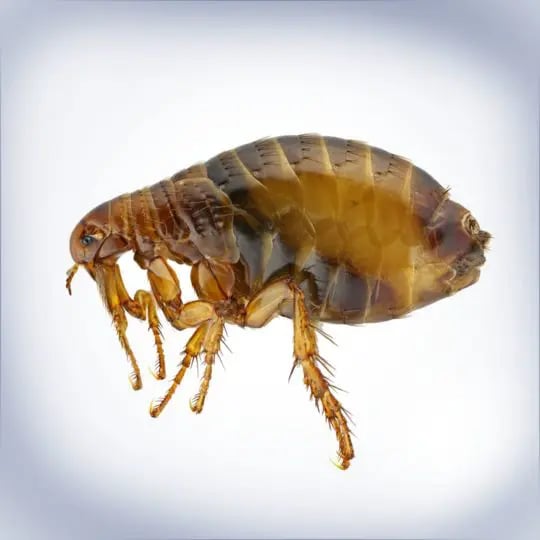
Scientific Name: Siphonaptera
Lifespan: 100 days.
Problem: Itchy bites. Bother pets.
Pests love fleas. Their eggs and larvae provide food for mites and nematodes, while dead fleas feed ants, spiders and even other fleas. Pets, on the other hand, find fleas to be a tremendous hassle, and human beings find that when there are fleas in their home, they often wake up with itchy bites.
Fleas can sometimes be eliminated simply by flea treating your pet. But significant flea infestations may need extra help, and turn your home into a minefield of flea bites.
The Flea Life Cycle
- Eggs – Female fleas lay up to 50 eggs a day, an amount equal to their body weight. The eggs are white in color, while the black spots you sometimes find in flea-infested pet fur are actually dried blood from flea bites. The eggs hatch between 2 days and 2 weeks after being laid.
- Juveniles – Flea larvae prefer dark places. Being unable to pierce skin and suck blood, they instead consume dead insects and vegetable matter. After 5-18 days the pupae weave a silk cocoon in which to pupate and mature. Pupae take 1-2 weeks to grow into their final form.
- Mature Bugs – Adult fleas are small, black or dark reddish-brown, and flat lengthwise. They cannot easily be crushed, and are very agile due to their strong back legs that allow them to jump 200 times their own body length (about 13 inches).
Flea Habitats and Habits
Fleas prefer moist, shady habitats when outdoors. However, their favorite habitat is mammal fur. Fleas will hitch rides and lay their eggs on mammals such as cats, dogs, local wildlife, and occasionally humans.
Fleas can survive cold temperatures and may return after hibernating or “overwintering” during the cold seasons, as soon as the temperature allows them to resume activity. Temperatures of about 70 degrees during the day are adequate to revive a flea infestation.
How to Recognize and Get Rid of Flea Infestations
If you believe you may have a flea infestation, a good way to check is to lay down a piece of light colored fabric on the floor in your home, or wear a light-colored pair of socks out into your yard. If after about a minute you notice fleas jumping onto the fabric, your residence can be considered infested.
Any pets should be flea treated first, combined with vacuuming the carpet to kill adult fleas. You may want to vacuum once a day to also get rid of eggs. When that is not enough or the fleas keep coming, you may need a more comprehensive flea control treatment.
Need Help with Identify Fleas | Flea removal Philadelphia PA & NJ?
Call today at and let's talk about how we can help you with Identify Fleas | Flea removal Philadelphia PA & NJ and other Pest Library.